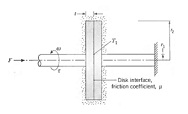Discuss the below in detail:
Q: In a test to determine the friction coefficient, µ, associated with a disk brake, one disk and its shaft are rotated at a constant angular velocity w, while an equivalent disk/shaft assembly is stationary. Each disk has an outer radius of r2 = 180 mm, a shaft radius of r1 = 20 mm, a thickness of t = 12 mm, and a thermal conductivity of k = 15 W/m · K. A known force F is applied to the system. and the corresponding torque T required to maintain rotation is measured. The disk contact pressure may be assumed to be uniform (i.e., independent of location on the interface), and the disks may be assumed to be well insulated from the surroundings.
(a) Obtain an expression that may be used to evaluate µ from known quantities.
(b) For the region r1 < r="">< r2,="" determine="" the="" radial="" temperature="" distribution,="" t(r),="" in="" the="" disk,="" where="" t(r1)="T1" is="" presumed="" to="" be="">
(c) Consider test conditions for which F = 200 N, w = 40 rad/s, t = 8 N · m, and T1 = 80°C. Evaluate the friction coefficient and the maximum disk temperature.
